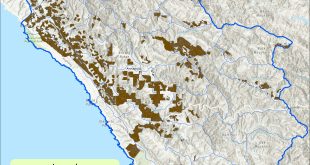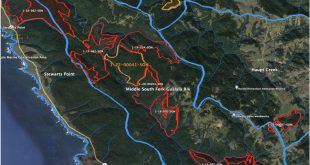THP 1-00-484 SON – Haupt Creek
FOREST UNLIMITED
P.O. Box 195
Cazadero, CA 95421
July 21, 2003
Director
California Department of Forestry
135 Ridgway Ave.
Santa Rosa, CA 95401
Dear Director:
The following comments refer to THP 1-00-484 SON and are made by Forest Unlimited on behalf of the Friends of the Gualala River.
The RPF’s discussion of the required Alternatives Analysis reveals a total misunderstanding of the purpose and function of the Alternatives Analysis. Apparently CDF shares that misunderstanding. Otherwise CDF would have returned it to the RPF for changes prior to filing. The Alternatives analysis is intended to uncover, compare and improve mitigations and reveal to both the public and the State agencies any and all potential environmental effects. By requiring comparison of environmental effects, It provides CDF with a sound basis for decisions. It is not intended to evaluate the economic merits of alternatives or even to force selection of the most environmentally beneficial alternative.
The so-called Alternatives Analysis in this THP fails to fulfill its legally required purpose. Instead, the RPF seems to believe that it is the place to justify his choice of alternatives. So, instead of making the required comparisons of environmental effects, he lists his reasons, many of them economic, for rejecting alternatives. He has subverted the very reason for an alternatives analysis.
Few of the legally required elements of an alternatives analysis are present. The courts have found that “the core of an EIR [or its functional equivalent the THP] is the mitigation and alternatives sections.” Clearly this THP is not structured around an “Alternatives Analysis” core, as it should be. Instead, the Alternatives Analysis is an anemic add-on, almost an afterthought.
The following elements should be included in any Alternatives Analysis to fulfill its legal mandate:
- A clear, detailed, quantitative, site-specific description of the present conditions in order to establish baseline data.
- A clear, enumerated statement of each of the projects objectives.
- A clear, detailed, site-specific description of each potential alternative.
- An analysis of each potential alternative’s feasibility including:
- financial analysis determining profit or loss,
- an analysis of technical feasibility and time requirements,
- an analysis of governmental restrictions and permits required,
- availability of required resources such as equipment, electricity and water, and
- a clear statement of which project objectives will be met by the alternative.
- A quantitative comparison (where appropriate) of each of the environmental effects with present conditions and with a well defined baseline of “no significant effect”.
The “Alternatives Analysis” in this THP is inconsistent with the requirements of CEQA in the following general respects:
- The alternative descriptions are not well defined nor site-specific. They fail to describe any of the alternatives in sufficient detail for actual comparative analysis or meaningful public comment as CEQA requires. Nor is there enough detail to enable the public to understand, evaluate, and respond to the RPF’s conclusions. Mere identification of an alternative is not an adequate description. “Public Purchase” or “Conservation Easement” is a title not a description. These titles are not sufficiently specific to determine either the feasibility or the environmental effects, let alone compare them. The lack of specific description prevents meaningful comparison and meaningful public review and therefore subverts the intent of CEQA. One cannot even determine whether an alternative is “remote or speculative” on the basis of these cursory titles.
- Some of the alternatives listed do not “offer substantial environmental advantages over the project proposal” as required by CEQA. The reason for this legal requirement illustrates the purpose of the Alternatives Analysis: to uncover overlooked potential environmental effects and suggest potential mitigations, and to foster informed decision making and public participation. This requirement is intended to prevent selection of bad alternatives just to make the proposed project look good.
- Insufficient information was produced to permit a reasonable choice of feasible alternatives. Nor was reasonable diligence used to investigate alternatives. For example, consider the “Public Purchase” alternative. There is no record that the present owner has inquired of the Sonoma Land Trust, the Bodega Land Trust, Land Paths, the Sonoma County Water Agency, the Sonoma County Agricultural and Open Space District or any coalition of neighbors regarding purchase of the parcel, the timber rights or a conservation easement. Where are the copies of the contact letters? The record does not contain the number or names of neighbors who were asked if they were interested in purchase of the property outright. There is no record of due diligence. Indeed without such diligence, the alternative cannot even be described. Without a description, the feasibility of the alternative is unknown. Only feasible alternatives are to be considered.
- The economic and technical feasibility of each alternative has not been established with evidence in the record. Mere assertion that an alternative is infeasible is not evidence. Sufficient evidence for economic feasibility is absent from the record. “If the agency finds certain alternatives to be infeasible, its analysis must explain in meaningful detail the reasons and facts supporting that conclusion.” The economic goals of the landowner are irrelevant in determining feasibility and are not a basis for refusing to analyze a feasible alternative. If an alternative provides sufficient revenue to offset costs, it is economically feasible. The size of the profit is irrelevant. Failure to meet some of the basic objectives of the project does not render it infeasible [cf. CEQA Guidelines]. The landowner is free not to pursue an alternative, but the RPF and CDF are not free to avoid its study simply because the owner rejects it.
- This “analysis” is cursory. Much of the so-called analysis is specious and irrelevant . The remainder does not provide sufficient information to make serious comparisons among alternatives. It should contain facts, analysis, and formal argument, not just the RPFs conclusions and opinions. Assertion and speculation is made in the “analysis” without supporting substantial evidence cited in the record [CEQA 21081.5]. The RPF’s unsupported opinion is not substantial evidence. Conclusory statements such as “The alternative land uses while feasible are not, in the opinions of the professional forester and the landowner, environmentally superior to the project described in the proposed THP”, offered without evidence are insufficient. The lack of substantial evidence subverts the intent of CEQA by denying the public the right to meaningfully comment. If evidence or facts supporting the RPFs conclusions are to be found elsewhere in the THP, then they should either be repeated as part of the arguments in the Alternatives Analysis or clearly referenced so that the public and the agencies know which facts are deemed support of the argument. If the facts are missing or not referenced, the public is denied its right to meaningfully comment. The validity of an argument and its conclusions cannot be critiqued. Two and one third pages is clearly cursory and courts have so found.
- This “analysis” is neither quantitative, comparative or complete. It fails to compare the relative impact of each alternative upon the same environmental resource potentially impacted. [PRC 21100(d) and CEQA Guidelines 15126]. Every effect considered for one alternative should also be considered for each of the other alternatives. For example, each alternative should be compared for soil erosion impacts. Indeed, the RPF made no comparisons whatsoever. The RPF is unable to determine the effects because he has failed to define the alternative in sufficient detail. Where is, for example, the comparison in watercourse canopy for each alternative? Of soil erosion? Of fog precipitation? Of toxic herbicides? The “analysis” is simply not complete. There is no data cited for any effect.
- The present condition of each relevant environmental parameter was never described quantitatively so a baseline can be established. Comparisons should be made against that baseline. What is the present bed loading of the creeks? What is the present canopy cover? Water temperature? The effects of all feasible alternatives, as well as the effects of the No Project alternative, should be compared with the present conditions (which are not the same as the No Project effects). Many of the impaired conditions would actually improve with the No Project alternative. For example, Sedimentation of creeks might improve over time with No Project. Such improvement is important for a listed watercourse.
- Economic impacts have been confused with environmental impacts. Although economic considerations are relevant when determining feasibility, they are not a legitimate reason to reject comparison of feasible alternatives. CEQA makes it quite clear that the amount of financial return is not an environmental impact. The RPF incorrectly excludes serious analysis of alternatives on the grounds that the alternative fails to meet the land owner’s objectives. This subverts the very intent of CEQA in requiring an Alternatives Analysis. After all, the No Project alternative never meets the land owner’s objectives and is still required! “The discussion of alternatives shall focus on alternatives to the project or its location which are capable of avoiding or substantially lessening any significant effects of the project even if these alternatives would impede to some degree the attainment of the project objectives, or would be more costly” [CEQA Guidelines].
- Obvious alternatives have been overlooked. For example, milling the logs on site would reduce or eliminate the need for heavy equipment and large log trucks. This would reduce soil disruption as well. It would also provide a substantial tax advantage if spread over a number of years. Horse yarding may be feasible and an experienced horse yarding firm is located nearby (Iron Horse).
- The RPF’s assertion that the preferred project has “no significant effect” on the environment meaningless speculation. This is because NO criteria or thresholds for “significant” have been established by CDF as required by CEQA Guidelines. Therefore, no valid conclusion concerning significant environmental effects can be reached!
What follows are specific comments regarding the “analysis” of each alternative. The RPF mentions only three objectives, although they are mixed with the discussion of the alternatives. They are economic return, regulation and management of the stand, and achievement of MSP. Because “regulation and management of the stand” couuld mean almost any type of management, it is really no objective as stated.
The RPF actually mentions nine project alternatives, although some of them are buried within the discussion of other alternatives. They are:
- No Project
- Convert to vineyards
- Build a residence
- Build a barn
- Sell the property to another private owner
- Sell the property to a group of private buyers
- Sell the property as a public park
- Use the property as pasture
- Log the property according to the proposed plan
In addition, the RPF discusses alternative sites, alternative timing of logging, and alternative silviculture. First let’s look at the alternative projects.
No Project: It is always true that the No Project alternative does not allow the owner to earn an economic return other than perhaps increased land evaluation and increased timber value. Economic return is only germane in the analysis of feasibility but because the No Project alternative is required by law, feasibility is immaterial. Nor does it matter whether the No Project alternative meets the owners objectives.
Simply asserting that “the no project alternative would avoid any potential impacts” or that the no project alternative “would create other impacts” fails to enumerate what those impacts may be. The supposed impacts are left unidentified and unquantified. Neither are they compared to a baseline as required. Indeed, there is nothing here to compare!
The degradation or improvement of each of the following environmental parameters should be identified, described and quantified if possible:
Mass Wasting
Sheet erosion
Water quality
Canopy cover
Site productivity
Wildlife habitat
Flooding
Aquifer recharge
Summer creek flows
Fog precipitation
Viewshed effects
Any other effects suggested by another alternative should also be included here.
Within the “No Project” discussion the RPF mentions three other alternatives: timberland conversion to agriculture, building a residence and building a barn. If they are legitimate alternatives, then they should be analyzed in detail separately. It is doubtful, however, that they meet the legal criteria of offering substantial environmental benefits.
Conservation Easement: The fact that the landowner is not interested in pursuing a conservation easement is not a legitimate reason for failing to analyze this alternative. That the RPF so states reveal that he misunderstands the reason for the Alternatives Analysis.
It has not been shown that such an alternative even fails to meet most of the landowner’s objectives. Conservation easements can be customized in an infinite number of ways. Some permit logging or home sites. Most result in significant tax advantages. Most offer some environmental advantages. But because the alternative has not been defined or described, it is impossible to tell what benefits there might be.
It is clear that the feasibility of this alternative was not investigated. There was no due diligence. There is no record of contacts with government or private agencies who may have been interested. There was no research into the economic benefits of easements. The RPF is required to analyze alternatives that offer substantial environmental advantages to the proposed project. By refusing to analyze this alternative, he has thrown away an opportunity to fulfill his statutory duty and cannot tell what advantages the alternative may have. Obviously the required comparison of environmental effects is missing. Totally.
Public Purchase: The assertion that “the project area does not include any special features or unique sites that would distinguish it from any other timberland in Sonoma County that has old-growth” is simply false. It is near the California Coast in proximity to a prime tourist area and within 3 miles of Fort Ross State Park. It effects a tributary to a listed watercourse. Nonetheless, such information is irrelevant to an Alternatives Analysis.
Once again the alternative is not well defined. It is impossible to evaluate the feasibility or the environmental advantages to such an ill-defined alternative. Public purchase by whom and for what purpose? Sonoma County Water Agency for a reservoir? Sonoma County Agricultural and Open Space District as open space? The State of California as a campground?
The RPF admits that personal correspondence suggests that “various groups” have offered to purchase the land. Is this correspondence in the record? Who are these groups and what did they wish to do with the land?
Once again the RPF rejects serious study of the option simply because the landowner does not want to sell. The fact is irrelevant to the intent and purpose of an Alternative Analysis. He has failed to discharge the requirements of the law.
Alternative Land Use: Here the RPF offers two such alternatives: pasture and vineyard. Neither appear to offer substantial environmental advantages and therefore should not have even been suggested. It is good that the owner is committed to MSP which is, after all, required by the law. Productivity is certainly one of the environmental effects that should be compared. Simply asserting that “alternative land uses while feasible are not…environmentally superior” is conclusory. There is no evidence presented, no logical argument provided. Merely the conclusion is stated. One cannot critique nonexistent evidence or arguments. The public is denied the right to meaningful comment.
Alternative Site: It appears that the RPF has rejected at least two alternatives sites because they are not technically feasible. This is appropriate because the law requires that he provide the reasons when an alternative is rejected as infeasible.
Alternative Timing: The reasons for the present timing, while important to the landowner, are irrelevant to the purpose of an Alternative Analysis. No alternate time has been suggested, so the alternative is ill-defined. Because it is not well-defined, whether it is feasible and whether it offers substantial environmental advantages cannot be determined.
Alternative Yarding Method: The RPF provides some information relevant to the feasibility of two yarding methods: tractor and helicopter. Topography is mention as prohibiting tractor yarding yet there is no reference made to slope information in the plan. Helicopter yarding is claimed to be “too expensive” yet no data is provided to substantiate the claim. Again the public is denied its right to meaningful comment because substantial evidence is missing.
Presumably other yarding methods were rejected, for example, horse yarding. Why is there no data on feasibility of other rejected methods?
Alternative Silviculture: The RPF informs us that the selected silviculture is “the best way to meet the landowners objectives.” If so, why didn’t he lay out the rational for that opinion so the public could meaningfully comment? Again, his statements are conclusory, devoid of supporting substantial evidence. He asserts that these methods are “most feasible” based upon the landowners objectives, “other issues mentioned above, economics, topography, etc.” This too is a conclusory statement presented without reference to substantial evidence.
It’s irrelevant to this plan and somewhat unprofessional to include a threat to clearcut in the future. Is he threatening retaliation if the public comments or CDF does its job? If the RPF failed to select the appropriate silviculture for this stand, is he submitting a flawed THP?
The Alternatives Analysis is not the place to justify the choice of silvicultural method. The Alternatives Analysis is the place to compare environmental effects of feasible silvicultures. Yet this discussion omits any serious comparison of the environmental effects, the very reason for an Alternatives Analysis.
The RPF is still making fundamental errors due to his lack of knowledge of the law. But in fairness to the RPF , CDF’s advisories to RPFs on this topic are misleading and not in conformity with CEQA. CDF needs to review and update these directives.
Very Sincerely,
Richard Coates
Executive Director
 Friends of Gualala River Protecting the Gualala River watershed and the species living within it
Friends of Gualala River Protecting the Gualala River watershed and the species living within it


